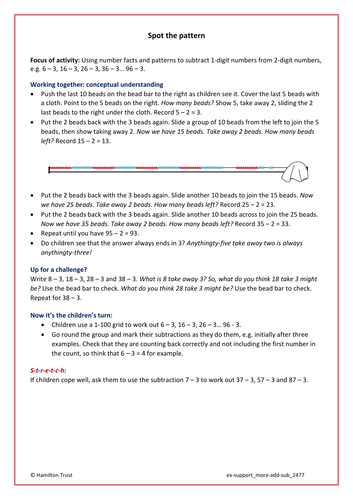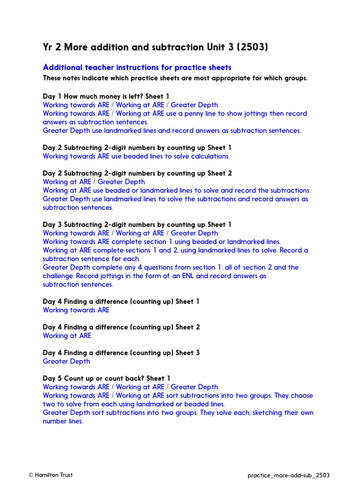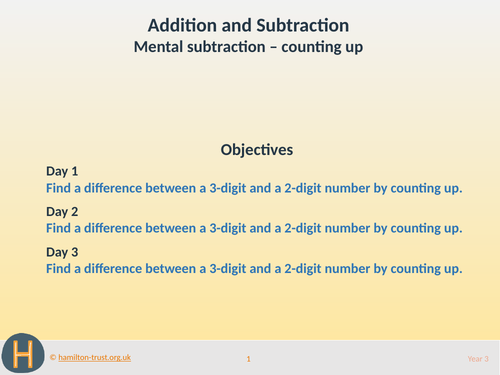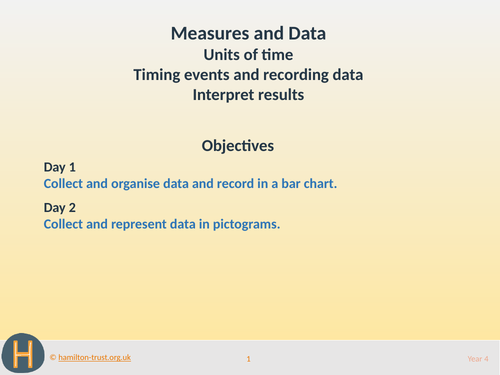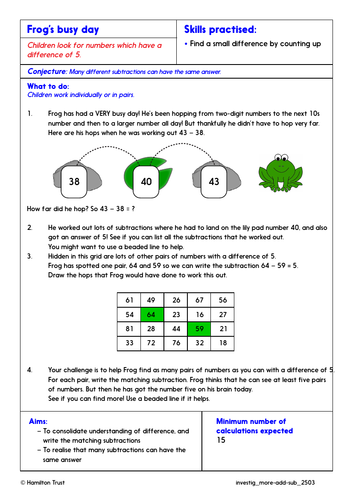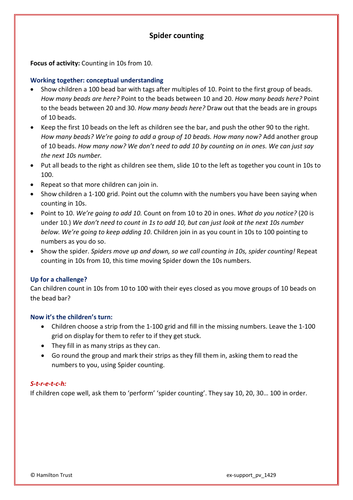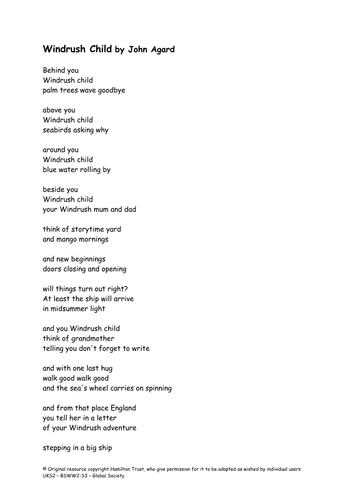
397Uploads
10040k+Views
11644k+Downloads
All resources

Extra Support Activity: Subtract by counting back. ( Year 2 More Addition and Subtraction )
This activity is designed to be used by a teacher or a TA with children who need extra support before they can tackle these objectives: Subtract 2-digit numbers by counting back.
Spot the Pattern - Using number facts and patterns to subtract 1-digit numbers from 2-digit numbers, e.g. 6 - 3, 16 - 3, 26 - 3, 36 - 3… 96 - 3
This Extra Support Activity is part of our Year 2 More Addition and Subtraction block. Each Hamilton maths block contains a complete set of planning and resources to teach a terms worth of objectives for one of the National Curriculum for England’s maths areas.

Practice Worksheets: Subtract by counting up. ( Year 2 More Addition and Subtraction )
Year 2 More Addition and Subtraction: Subtract 2-digit numbers by counting up; choose a strategy.
Procedural fluency practice worksheets to achieve maths mastery. Differentiated for children working towards Age Related Expectations (ARE), at ARE and at greater depth.
Day 1 - Find how much money is left over when children buy a drink by finding the difference.
Day 2 - Use Frog (counting up) to solve subtractions.
Day 3 - Subtract 2-digit numbers by counting up.
Day 4 - Use number lines to find the difference by counting up.
Day 5 - Choose an efficient strategy to solve subtractions.
These procedural fluency practice sheets are part of our Year 2 More Addition and Subtraction block. Each Hamilton maths block contains a complete set of planning and resources to teach a terms worth of objectives for one of the National Curriculum for England’s maths areas.

Teaching Presentation: Using place value to add/subtract. ( Year 3 Addition and Subtraction )
This presentation provides five days of teaching that cover the objectives:
Using place value to add/subtract
It includes starter activities, whole class teaching, group activities, practice sheets and mastery questions. It can be used on a variety of interactive whiteboards.
Day 1 Teaching
Display a place value grid and write 3-digit numbers on it. Show which digit changes if you add multiples of 10. Repeat to show which digit changes if you add multiples of 100. Repeat for 1s.
Day 2 Teaching
Use a place value grid to show which digit changes if you subtract multiples of 10. Repeat for multiples of 100 or 1.
Day 3 Teaching
Demonstrate how to add and subtract near multiples of 10 to/from 2-digit numbers using a number line, and also a 1-100 number grid.
Day 4 Teaching
Use an empty number line to model the hops involved in adding a near multiple of 10 to a 3-digit number: 225 + 29 is 225 hop 30 along and then back 1, etc.
Day 5 Teaching
Use an empty number line to model the hops involved in subtracting a near multiple of 10 from a 3-digit number. Demonstrate how we adjust the hops to subtract 51 or 49 rather than 50.
This teaching is part of Hamilton’s Year 3 Place Addition and Subtraction block. Each Hamilton maths block contains a complete set of planning and resources to teach a term’s worth of objectives for one of the National Curriculum for England’s maths areas.

Teaching Presentation: Mental subtraction – counting up ( Year 3 Addition and Subtraction )
This presentation provides three days of teaching that cover the objectives:
Mental subtraction – counting up
It includes starter activities, whole class teaching, group activities, practice sheets and mastery questions. It can be used on a variety of interactive whiteboards.
Day 1 Teaching
Remind children of Maths Frog. Demonstrate how we can count up along an empty number line using Frog to work out the difference between 87 and 102. Model several subtractions.
Day 2 Teaching
Demonstrate counting up using Frog hopping along a number line to show how we calculate 113 – 78. Stress how we add the hops to find the answer.
Day 3 Teaching
Use Frog and the empty number line to perform subtractions (112 – 76) and make deliberate errors which children have to correct.
This teaching is part of Hamilton’s Year 3 Addition and Subtraction block. Each Hamilton maths block contains a complete set of planning and resources to teach a term’s worth of objectives for one of the National Curriculum for England’s maths areas.

Teaching Presentation: Units of time, record data and interpret ( Year 4 Measures and Data )
This presentation provides two days of teaching that cover the objectives:
Units of time
Timing events and recording data
Interpret results
It includes starter activities, whole class teaching, group activities, practice sheets and mastery questions. It can be used on a variety of interactive whiteboards.
Day 1 Teaching
Four children write their name 20 times and four others time them. Record times in a table. Discuss how we can draw a bar chart to represent this data. What scale shall we have? Try 1 step = 5 or 10 seconds. Which will fit on the page but not look too small? Discuss and draw a bar chart. Discuss questions that could be asked about the data. Children then write their name 10 times and record the time.
Day 2 Teaching
Show children the table showing the number of children that were born in the first 7 months of the year. Discuss this. Say that we will represent this information in a pictogram – one picture represents four units. Draw this together.
This teaching is part of Hamilton’s Year 4 Measures and Data block. Each Hamilton maths block contains a complete set of planning and resources to teach a term’s worth of objectives for one of the National Curriculum for England’s maths areas.

Subtraction with decimals, e.g. money - Problem-Solving Investigation - Year 5
This in-depth maths investigation is an open-ended problem solving activity for Year 5 children. It can be used to support teaching towards the objective subtraction with decimals including money.
In-depth Investigation: Decimal Differences
Children subtract pairs of numbers with consecutive digits and different numbers of decimal places, and look for patterns in their answers.
This investigation will develop maths meta-skills, support open-ended questioning and logical reasoning, and enable children to learn to think mathematically and articulate mathematical ideas.
This problem-solving investigation is part of our Year 5 Decimals and Fractions block. Each Hamilton maths block contains a complete set of planning and resources to teach a term’s worth of objectives for one of the National Curriculum for England’s maths areas.

Expanded & compact column subtraction - Extra Support Activity -Year 4
This activity is designed to be used by a teacher or a TA with children who need extra support before they can tackle these objectives: Use expanded and compact column subtraction with numbers <1000
Hops to 100 and Beyond - Using counting up (Frog) to subtract numbers either side of a multiple of 100, e.g. 304 – 297, then 304 – 267
This Extra Support Activity is part of our Year 4 Decimals and Fractions block. Each Hamilton maths block contains a complete set of planning and resources to teach a term’s worth of objectives for one of the National Curriculum for England’s maths areas.

The Union Flag!
Waving the flag! Using the Olympic timeline the children identify the last four countries and cities to host the Summer Olympic Games. The flag for Great Britain is pulled apart to see which countries make up the Union Jack.

Problem-Solving Investigation: Subtract by counting up. ( Year 2 More Addition and Subtraction )
Year 2 More Addition and Subtraction: Subtract 2-digit numbers by counting up; choose a strategy.
This in-depth Maths Investigation will develop maths meta-skills, and enable children to learn to think mathematically and articulate mathematical ideas.
In-depth Investigation: Frog’s Busy Day
Children look for numbers which have a difference of 5 using Frog to help.
This problem-solving investigation is part of our Year 2 More Addition and Subtraction block. Each Hamilton maths block contains a complete set of planning and resources to teach a terms worth of objectives for one of the National Curriculum for England’s maths areas.

Extra Support Activity: Subtract by counting up. ( Year 2 More Addition and Subtraction )
This activity is designed to be used by a teacher or a TA with children who need extra support before they can tackle these objectives: Subtract 2-digit numbers by counting up; choose a strategy.
Tall Towers - Finding a small difference.
This Extra Support Activity is part of our Year 2 More Addition and Subtraction block. Each Hamilton maths block contains a complete set of planning and resources to teach a terms worth of objectives for one of the National Curriculum for England’s maths areas.

Extra Support Activity: Count in 10s; say numbers 10 more/less. ( Year 1 Place Value )
This activity is designed to be used by a teacher or a TA with children who need extra support before they can tackle these objectives: Count in 10s and say numbers 10 more and 10 less.
Spider Counting - Counting in 10s from 10.
This Extra Support Activity is part of our Year 1 Place Value block. Each Hamilton maths block contains a complete set of planning and resources to teach a term’s worth of objectives for one of the National Curriculum for England’s maths areas.

Teaching Presentation: Rehearse 24 hour clock; time intervals ( Year 4 Measures and Data )
This presentation provides two days of teaching that cover the objectives:
Rehearse 24 hour clock
Time intervals
It includes starter activities, whole class teaching, group activities, practice sheets and mastery questions. It can be used on a variety of interactive whiteboards.
Day 1 Teaching
Revise 24-hr clock using a train timetable and relating times to the school day. Convert 24-hour clock times to am and pm times and vice versa. Count in steps of 1 hour on a counting stick from different starting times, through midday and midnight.
Day 2 Teaching
Visit an online TV guide. Children write start times using 12-hour format (they are in 24-hour format on the website). Children find programmes lasting less than half an hour, then those lasting more than half an hour. Scroll for a programme crossing an hour. Sketch a time line jotting to show how to find the length of this programme. Repeat.
This teaching is part of Hamilton’s Year 4 Measures and Data block. Each Hamilton maths block contains a complete set of planning and resources to teach a term’s worth of objectives for one of the National Curriculum for England’s maths areas.

Teaching Presentation: Tell time to nearest minute: am/pm ( Year 4 Measures and Data )
This presentation provides three days of teaching that cover the objectives:
Telling time to nearest minute; am and pm
It includes starter activities, whole class teaching, group activities, practice sheets and mastery questions. It can be used on a variety of interactive whiteboards.
Day 1 Teaching
Launch ITP Tell the time. Recap telling the time by moving the minute hand around clock at 5-minute intervals. Establish that there are 5 divisions between the numbers, each of which represents 1 minute. Count marks with children to tell time to the minute. Distinguish am and pm as morning and afternoon/evening.
Day 2 Teaching
Imagine school started 40 mins later. Find all the activity times, now 40 mins later, crossing the hour as necessary. Record times in both analogue and digital times, and work out time intervals.
Day 3 Teaching
Show children that to calculate time intervals, we can use Frog to find the difference between times like finding a difference between 2 numbers on a number line. Model finding time intervals using Frog, crossing the hour, using both analogue and digital clocks.
This teaching is part of Hamilton’s Year 4 Measures and Data block. Each Hamilton maths block contains a complete set of planning and resources to teach a term’s worth of objectives for one of the National Curriculum for England’s maths areas.

Begin to understand percentages - Practice Worksheets & Answers - Year 5
Year 5 Decimals, Percentages, Fractions: Begin to understand percentages.
Procedural fluency practice worksheets to achieve maths mastery. Differentiated for children working towards Age Related Expectations (ARE), at ARE and at greater depth. Includes answers.
Day 1 - Write the percentage of each 100-square that is shaded, then an equivalent vulgar and decimal fraction.
Day 2 - Convert fractions to percentages.
Day 3 - Find percentages of amounts: multiples of 100.
Find percentages of amounts: multiples of 10 and 100.
These procedural fluency practice sheets are part of our Year 4 Decimals and Fractions block. Each Hamilton maths block contains a complete set of planning and resources to teach a term’s worth of objectives for one of the National Curriculum for England’s maths areas.

Adverbials - Presentation & Exercises
Grammar teaching presentation and grammar exercises.
The cat themed teaching presentation includes 22 slides.
Revise verbs and then look at:
Adverbials
Prepositions
Fronted adverbials
How to punctuate fronted adverbials
How to use more than one adverbial in a sentence
Clear examples are provided throughout.
We then provide grammar exercises for children to:
Identify adverbials in a passage
Add adverbials to a sentence
Each collection of exercises is made up of three sets. Set A is the easiest or most accessible, Set C is the hardest or uses more complex language.
This resource is aimed at UKS2. Use the presentation to introduce or revise a grammatical concept as a stand-alone lesson or add on the accompanying exercises for children to practise and apply their knowledge.

Year 1 Fiction 3: Stories with repeating patterns and counting stories
Read a story with repeating patterns, Bringing the Rain to Kapiti Plain, by Verna Aardema. Retell the story using flow charts, write describing words and punctuate sentences. Read two counting stories Handa’s Hen by Eileen Browne and We All Went on Safari by Laurie Krebs, before guiding children to write their own. The Hamilton Group Reader, Boris and Sid go on a tram, is used to develop confidence in reading aloud.

Windrush
Read the poem Windrush Child by John Agard and get children’s reactions. Give brief history of SS Windrush’s journey to Britain in 1948. Children either mark the journey on a map or answer questions about photographs to do with Caribbean immigration on the Windrush.

